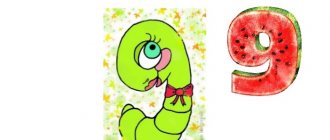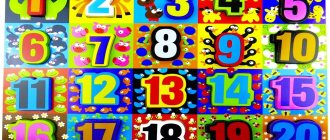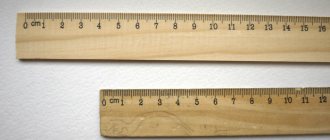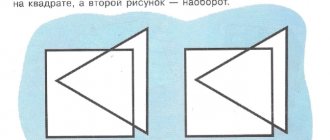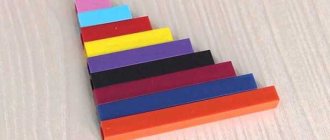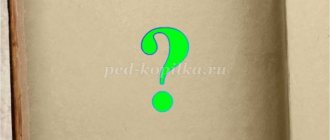MAGAZINE Preschooler.RF
Prepared by teacher: Okorokova E.V. MDOUd,/s. No. 8, Kropotkin-2009 TOPIC: “Numbers from 1 to 10” Purpose: a) summarize and systematize students’ knowledge on the topic “Numbers from 1 to 10”; b) consolidation of knowledge acquired in previous classes; c) determining the location of objects in space; ^consolidate knowledge of adjacent numbers to the named number “before” and “after”. Equipment: animal toys, counting sticks, signal cards, boards, crayons, cubes (red, yellow, green) and triangles, mushrooms / for each correct answer /, ball. PROGRESS OF THE LESSON I. Organizational moment: The bell rang loudly - The lesson begins. Our ears are on top of our heads, our eyes are wide open. We listen, we remember, we don’t waste a minute, Educator: Today a guest came to our lesson, but first we must find out where she is from. To do this, we need to put the numbers in ascending order and decipher the word.On the board: 6 2 4 s l e What word did you get? Children: Forest. Educator: Not a mouse, not a bird came running to us from the forest, frolicking in the forest. Lives in trees and gnaws nuts. Who is this? (Squirrel) /the teacher attaches a drawing of a squirrel to the board/
II. Reporting the objectives of the lesson:
The hostess squirrel opens the school and invites the forest animals to study. Both animals and birds rush to our class, And the squirrel, the teacher, Gives the following order: “Let’s start our lesson, We will repeat the counting and solve examples, Who will learn more carefully,”
Sh. Consolidation of what has been learned: 1).Find the Squirrel mistake. Mishka barely came out from behind the spruce after the little wolf. He shakes his head and talks to himself. Bear. I have a calculating machine, it helps me. I have decided all the examples, but I don’t have the strength to check. Here are the answers in front of you, you, friends, check for yourself. -Children check solved examples. Incorrect results in examples 3 and 4 are removed from the board, and the examples are solved correctly. On the board: 5-1=4 7+1=8 3+2=5 6-5=1 /sign. card./ Squirrel. The beluga bear roared and rushed around in circles. Bear. Ay, car. Well done! Well, you're not at all accurate! Squirrel. Don’t be upset, Mishka, but learn from the kids! Educator: Guys, let’s explain to Mishka again how to add and how to subtract. 2). Composition of the number “5”, Squirrel. A cunning little fox sat under a bush. He listened to the chirping of birds and waited for the prey to come to visit. And we will hide the birds in the houses, But you need to know the composition of the number. On the board are drawings of houses, a fox and birds with numbers on their wings. The guys are moving the birds into houses.
IV. Oral counting: Squirrel. Bunny, bunny, look, name all the figures. Hare. Oh, I don’t know, oh, I’m afraid, For some reason I’m shaking all over. Squirrel. You must answer boldly, but being timid is a bad thing. Which of the guys will help? Educator: Name the figure in the upper left corner, indicate its color. Children: Yellow triangle. Educator: In the lower right corner? Children: Orange square. Educator: Where is the green circle? Children: In the upper right corner. Educator: What kind of figure is this? Children: Oval. Squirrel. I prepared some tablets for you guys. Now pay attention. Let's listen to the task. Draw these figures on your board with chalk from memory. The sample is removed. Children draw. The teacher checks the drawn figures. Squirrel. Write down in the triangle the number that comes before the number b, in the square - after the number 7, in the oval the number that is 1 more than 3, in the circle - 1 less than 9. Summarize the results of this stage of the lesson. V. Development of computing skills. Educator: The gray wolf came running to class, He also wants to master counting, He looks at the examples on the board, How to solve these examples? Help the Wolf, children! Explain to him how to add and subtract 1.2. Children: Add 1 - name the next number when counting, subtract 1 - name the previous one, 2 - add as +1+1, subtract 2 as -1-1, Children solve examples: 3+1 5+2 6-1 7-2 Squirrel. Now make an example about these animals. Here are five bunnies walking along the path. Two people run after them. So how many bunnies are hurrying along the forest path to school in the spring? Children: make a decision at the cash register /write it down on the board/
VI. Physical education lesson The wind is blowing in our faces, / The children are waving their hands at themselves, / The tree is swaying. / The children bend over. / The wind is quieter, quieter, quieter, / The children are crouching. / The tree is getting higher, higher. / Children stand on their toes, stretch upward / VII. Practical work Well done guys, they helped all the animals. And now I’ll give you another task. Build a tower of squares / cubes / so that the red cube is higher than the yellow one, but lower than the green one. - What color was the cube on top? (Green.) - Which cube was lower than the red one? (Yellow.) Place 1 triangle to the right of the tower, and 2 triangles to the left.
VIII. Didactic game: a) “Catch the ball and name the number”; b) “Mathematical Lotto” - (children find the sum of numbers)
IX. Summary of the lesson Squirrel. You, my friends, tried, Everyone worked diligently. I want to thank you and give everyone grades. The teacher evaluates the children's work. Summarizes the work.
| Next > |
Fun and effective learning to count
In the company of loving parents, learning to count and form numbers turns into an exciting activity. In order for the child to be able to assimilate and clearly appreciate everything that the elders explain, you will need:
- counting sticks;
- scores (they can be attracted by playing shop);
- cubes;
- homemade cards;
- number houses;
- toys or candy;
- buttons of different colors.
Lesson 1: concept of number composition
The abacus will help you learn all the numbers.
You can use them while playing shop. Toys, children's dishes, cubes, and other identical household items will help develop a child's interest in mathematics. The study begins with the number 2, asking the child to put a cube on the table and specifying what needs to be done to make two of them. Usually a 5-6 year old child is able to guess what is going on. A younger child can be given a hint.
The exercise should be reinforced using other objects. It is important for the child to remember that the number 2 in any case includes two units, regardless of what items make it up (2 cans, 2 books, 2 pieces of soap, and so on). Let him place on the table 2 items that he likes (pebbles, cubes, berries, chestnuts or nuts).
- lay out 3 coins one at a time (at different distances or “in a column”);
- add one to two coins (put two coins together, and one at a distance);
- add two to one coin.
After the child has mastered the “three” (understands that three coins together is the same as two coins with one, and has practiced putting them together), you can teach the number 4 in a playful way. Checkers and a board will help here. You should invite the little student to place 4 white checkers on the board, and then ask the question: how many checkers will remain if you replace one white checker with a black one? How many of them will there be in total if you line up 2 white and 2 black checkers? It is important for the child to understand that the number 4 will be obtained with any rearrangement.
Involving a preschooler in solving everyday problems will help teach the correct composition of numbers. For example, ask him to lay out the forks for a family dinner. First, you can give him one device and ask how many more he needs for the family. After thinking, the child will be able to give the correct answer. Studying the cards together will also allow you to quickly master the composition of the number.
Lesson 2: working with cards
You can easily make cards with numbers yourself.
At this stage, it is important to connect 2 types of cards (purchased or made yourself). It is desirable that in the first version they consist of two halves. An object can be drawn on one side, and 2,3,4,5 or more copies of it on the other. The halves can be united by a “+” sign, or it can be done separately.
The second version of the cards is a set of pictures where objects are depicted as a single set, without division. When your child can match numbers and numbers, you can make a third set of cards with digital images. There should be enough cards so that he can imagine the same number in different versions (for example, 5 is 1 and 4, 2 and 3, 3 and 2, 4 and 1).
Lessons with cards are held in a relaxed manner. The child should be shown a card that shows, for example, 6 snowflakes and asked to collect the same number of snowflakes from the proposed pictures. It is important to switch roles sometimes. The child gives adults tasks, corrects their intentional mistakes, and learns to control the actions of other people. Similar work is being done with digital cards. The child must learn to select several options for the composition of the proposed number.
Lesson 3: connecting number houses
Number houses can be drawn in a notebook or made from colored paper; the child will put the necessary cards with numbers in the windows of the house.
Number houses help strengthen mental counting skills. They are presented in textbooks, but you can draw pictures yourself. Each house has a roof and several apartments located in 2 rows. The height depends on the number to which the combinations are selected. For example, for a double, 2 floors are enough (1+1, 2+0), for a triple, 3 (1+2.2+1.3+0) and so on.
You can draw houses with your child, showing at the same time why and how to fill them. A number from 2 to 10 is written in a triangle on the roof. The child is explained that there are as many residents living in two apartments on the same floor as indicated on the roof (for example, 5 residents). Let one person live in one of the apartments on the lowest floor, then with the help of counting sticks the kid determines that there are 4 residents in the second one.
As the child climbs the floors and populates them, he will determine the composition of the pairs (1 and 4, 2 and 3, 3 and 2, 4 and 1). To consolidate the result, you can hang sheets of houses around the apartment so that the child learns to fill them in with a pencil. When the baby masters composition 10, you can move on to a more complex program.
Options for number houses that can be easily printed or made by analogy:
Option 2:
Mastering the second ten numbers
Explaining to a child in an accessible form how to obtain numbers greater than 10 is not always easy. First, it is important to master mental counting to 20, to show your child how to write all the numbers he has learned. The question of why and why 7+4 is written as 11 will definitely arise. It is important to explain on paper that for convenience, large numbers are counted by 10. Adding 7 and 3 is ten, but you need to add 4, that is, one is missing. It turns out that the result is 7 + 3 and one more, that is, 11.
Another visual exercise can be done with nuts, candies, and construction kit parts. You should count 15 items and write down their number in numbers. Then decompose them into 10 and 5 and show that ten in a two-digit count is written as one, and 5 is the number of ones. It is also worth doing by counting 20 objects and showing that it includes 2 tens, and the number 21 is the same, plus one more.
